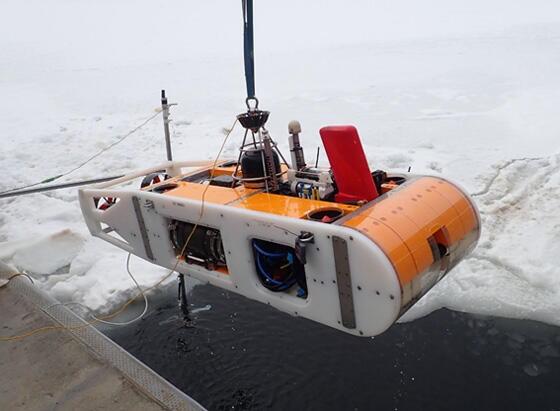A research group led by Associate Professor Toshihiro Maki, Special Researcher Hirokazu Yamagata and graduate student Shuma Kochii, of the Center for Integrated Underwater Observation Technology, Institute of Industrial Science, the University of Tokyo, and Professor Yoshifumi Nogi of the Geoscience Group, National Institute of Polar Research (NiPR), has developed a new autonomous underwater vehicle (AUV) for exploring under the sea ice and ice shelves of the Antarctic, known as the MONACA (2.1m long, 0.65m wide and 0.4m tall. Weight in air: 235 kg, main body only). In Mombetsu Harbor, Hokkaido, it successfully surveyed the surface contours of sea ice while maintaining a relative position to the ice for the first time in Japan.

(Credit: Institute of Industrial Science, The University of Tokyo, NIPR)
The research group has been developing MONACA since 2017 in order to explore the underside of Antarctic ice. To ensure that MONACA returns safely to the point it was immersed once it has made its journey to take measurements deep under the ice, it is equipped with a sensor unit equipped with a multi-beam sonar, a Doppler Velocity Log (DVL), and an inertial navigation system (INS), as well as an ice-relative navigation algorithm using the sensor.
Underwater trials using MONACA were undertaken in Mombetsu Harbor, Hokkaido, in February. It was launched 27 times, for a total of 8 hours 17 minutes and covering a distance of 8.9 km in automated submarine travel below the ice. This series of dives obtained topographical data from beneath 47,143 square meters of sea ice and across 5,875 square meters of seafloor. One of the expeditions (10 minutes, traveling 80 meters) was conducted without any safety cable attached.
Maki explains that, "We have been making changes as we go along, while increasing the difficulty in steps beginning with testing in a tank and moving onto testing in shallow seawater. Now, we will improve the positional control algorithm and establish a method for operating the MONACA from large ships like the Shirase, as we will shortly be embarking for Antarctica. MONACA is as easy to control as a traditional testbed AUV, and we hope it finds plenty of applications in observations outside of Antarctica too. Of course it can be used for exploration of the Arctic, as well as for undersea mining and investigation of seafood stocks."
This article has been translated by JST with permission from The Science News Ltd.(https://sci-news.co.jp/). Unauthorized reproduction of the article and photographs is prohibited.




